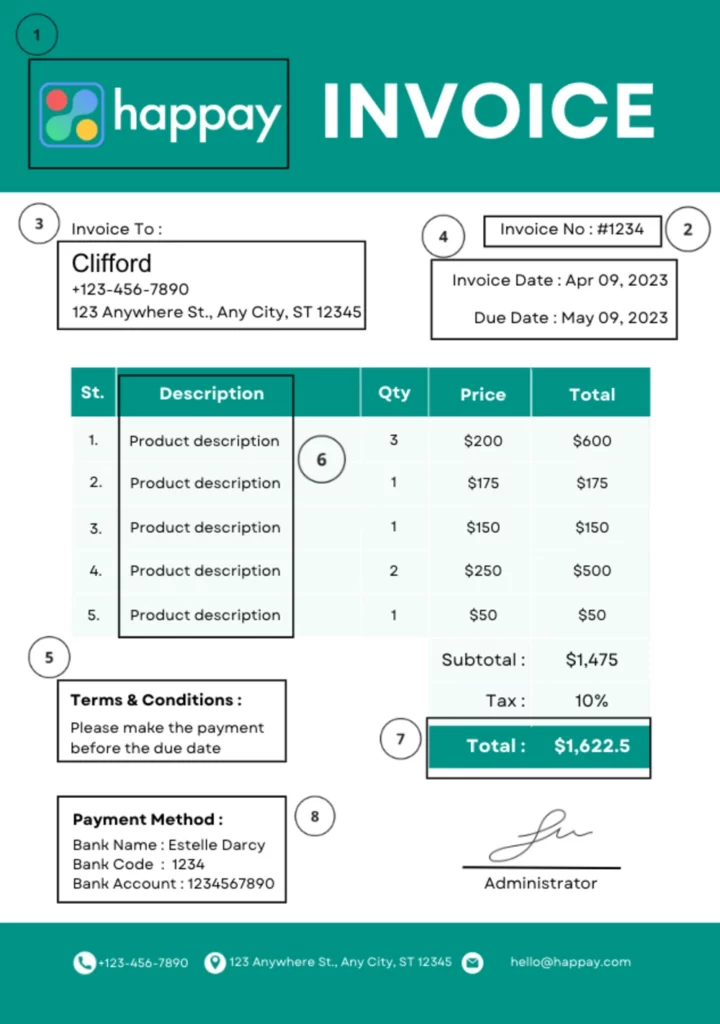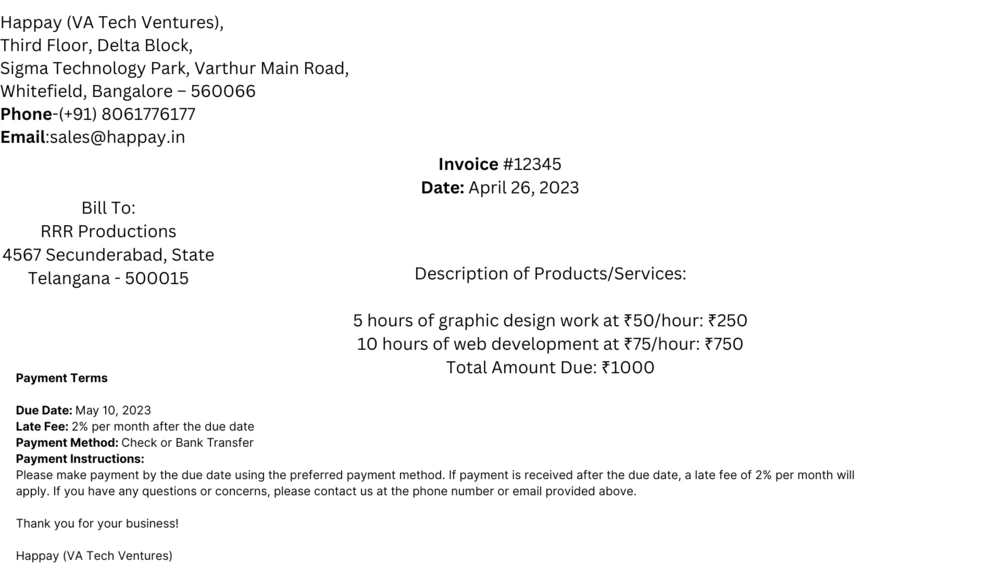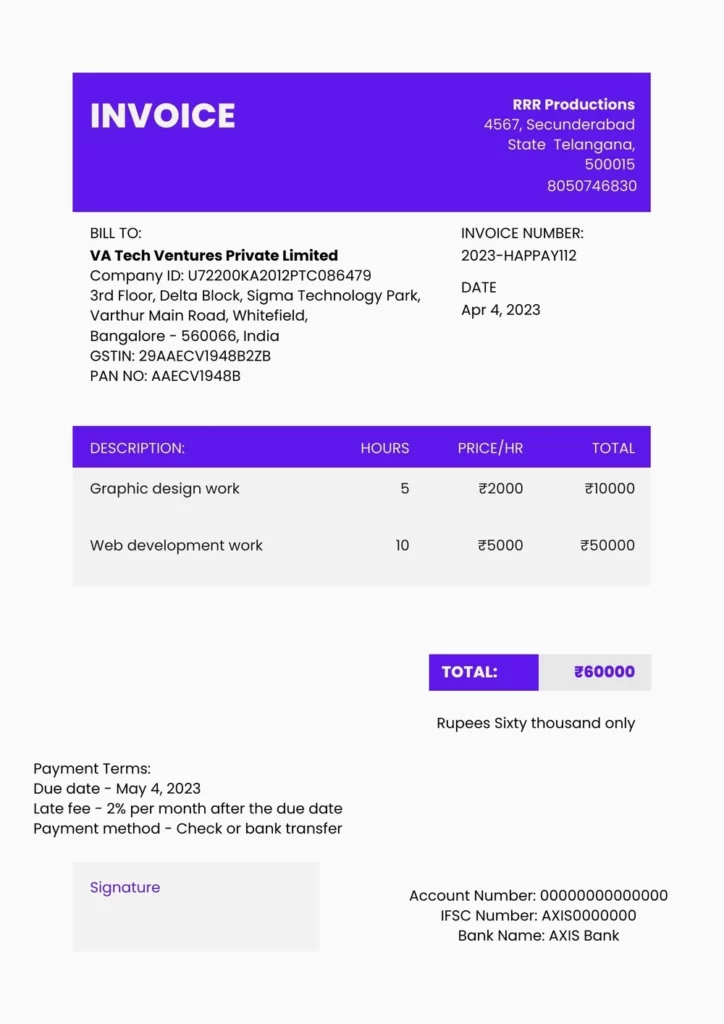Last Updated on November 28, 2025
What is an invoice?
It is a legal business document that assures parties of payment for goods provided or services rendered. An invoice is a piece of paper (or electronic record) that can make our hearts skip a beat or our stress levels skyrocket, depending on your position!
What is an invoice used for?
It’s like a gentle nudge to your customer saying, “Hey, remember that amazing product or service I provided you? Well, it’s time to pay up!” It’s like a financial love letter that expresses your hope for timely payment and a mutually beneficial business relationship.
These documents come in all shapes and sizes, from old-school paper bills that you can physically hold in your hand to sleek and shiny e-invoices (electronic) that pop up in your inbox.
But no matter how it looks, it typically includes some key info – your contact info and your customer’s, a unique number to keep things organized, a date, payment terms to set the rules of the game, and of course, a detailed list of the products or services provided with their prices.
Invoices are a crucial part of your business’s financial flow, and mastering the art of invoicing can help keep your cash flow healthy and your sanity intact.
Also, Read: What is Invoice Management?
Invoice meaning
In simple terms, the invoice definition refers to bills sent by organizations to customers. These documents outline the details of a transaction, including the products or services provided, the prices, and the payment terms.
It is a formal request for payment, showing proof of the amount owed by the customer to the business. In simpler terms, it is a bill that a business sends to a customer, asking them to pay for goods or services rendered.
Quick read: Invoice Vs Receipt: Importance, Differences, and Components
The purpose of using an invoice
Invoices are crucial for businesses, as they provide a transparent record of products/services, prices, and payment terms, establish a legal agreement for payment, facilitate efficient financial record-keeping, and ensure timely payment management.
These valuable pieces of paper help businesses maintain transparency, financial accuracy, legal compliance, and cash flow management, making them an essential tool for successful enterprise operations.
Here are the many reasons why organizations use them.
- Transparency: Invoices provide a clear and transparent record of the products or services provided, their quantities, prices, and any additional charges, ensuring that both parties have a clear understanding of the transaction details.
- Legal Agreement: These documents serve as legally recognized documents that establish a formal agreement for payment between the business and the customer, outlining the terms and conditions of the transaction and protecting the rights and interests of both parties.
- Record-keeping: These documents facilitate efficient financial record-keeping, helping businesses maintain accurate and organized financial records for auditing, tax reporting, and financial analysis purposes.
- Payment Management: A bill clearly states the amount due, the due date, and any payment terms, helping businesses manage their cash flow effectively and ensuring timely payments from customers.
- Professionalism: When you use formal documents for money due, it adds a level of professionalism to business transactions. It showcases the business’s legitimacy and builds trust with customers.
- Dispute Resolution: Formal documents of proof serve as evidence in disputes or discrepancies in the transaction. It provides a reference point for resolving any issues that may arise.
- Financial Analysis: Invoices provide valuable data for financial analysis, allowing businesses to track sales, monitor revenue, and assess profitability. It also aids in strategic decision-making and business planning.
- Compliance: These official documents prove that businesses comply with legal requirements, ensuring that the business operates according to the law.
- Payment Tracking: Formal and legal documents allow businesses to track and reconcile customer payments, helping manage accounts receivable and monitor outstanding payments.
- Professional Communication: Any official documents serve as a formal means of communication between the business and the customer, conveying important information about the transaction and facilitating clear communication channels.
Therefore, these documents serve multiple purposes in business transactions, including ensuring transparency, establishing legal agreements, facilitating record-keeping, and managing payments.
Quick Read: What is Invoice Financing?
Types of invoices
There are numerous types of invoices that enterprises may use. While some may be differently named, they can be classified into the following categories.
1. Pro Forma Invoice
Proforma Invoice: Imagine you’re selling products to an international buyer and need to provide them with a preliminary bill/invoice for customs clearance. This document includes details of the goods, such as descriptions, quantities, and prices, but it’s not a demand for payment. It’s like a “sneak peek” of what they’ll be paying for.
2. Commercial Invoice
Now, let’s say the buyer has received the goods, and it’s time for them to pay up. You’ll send them a commercial invoice, which is standard for international trade. It’s like a regular bill giving detailed information about the goods, their value, and other important details.
3. Interim Invoice
If you’re working on a long-term project requiring installments or milestone payments, you’ll need an interim bill. It’s like a progress report with a payment request. For example, if you’re building a house for someone, you might send them an interim bill for the completed work and request payment accordingly.
4. Recurring Invoice
Do you have a subscription-based service where customers need to pay regularly, such as monthly or annually? Like your monthly Netflix subscriptions, a recurring bill is an automatic reminder sent out regularly.
5. Credit Invoice
Sometimes, customers return goods or overpay you, and you need to issue them a refund or credit. This credit note reflects the credit or refund owed. For example, if a customer returns a product, you’ll issue them a credit note for the refund.
6. Debit Invoice
On the other hand, a debit note is the other side of a credit note. For instance, if a customer requests extra services beyond the scope of the original agreement, you’ll send them a debit note.
7. Time-sheet Invoice
If you’re billing your services based on time spent, such as hourly rates, you’ll need a time-based invoice. It’s like a detailed breakdown of the time you’ve spent and what you’re charging for it. For example, if you’re a freelance consultant charging hourly, you’ll send your client a time-based bill showing the hours you’ve worked.
8. Progress Invoice
Lastly, if you’re working on a large project or contract that’s progressing in stages, you’ll need a progressive bill. You’ll show the work completed, the percentage of completion, and the corresponding payment due for that stage. For example, if you’re building a website, you might send a bill for each phase completed.
Suggested Read: Difference Between Invoice and Bill
Essential elements of an invoice
a) What are the elements of an invoice?
Here are the main parts of any invoice.
- Your Business Information: Just like introducing yourself, your document should have your business information at the top. This includes your company name, address, phone number, and email.
- Invoice Number: This is a unique order number for your document. It helps you and your client keep track of the payment. It’s like the “Order #123” on your online purchase receipt.
- Client Information: The client’s details, such as their name, address, and contact information, is included here.
- Invoice Date: Just like marking the date on a calendar, you need to include the date when the document is issued. It’s like putting a timestamp on your invoice.
- Payment Terms: This is like the “fine print” in any document. It includes details about when and how you expect to be paid, such as the due date, late fees, and payment methods. It’s like setting the ground rules for getting paid.
- Description of Products/Services: This part includes a clear description of the products or services you provided, along with the quantity, unit price, and total amount.
- Total Amount Due: This is the grand total of the amount due, including any taxes, discounts, or other charges.
- Payment Instructions: You must remove any ambiguity in your documents. So, include your preferred payment method, bank details, and any other relevant information.
Remember, the main goal of an invoice is to clearly communicate the details of the products or services you provided and the payment terms to your client. So, make sure to include all the necessary elements to ensure smooth payment processing.

b) An Invoice Example
Let’s look at an example of how Happay Tech Solutions, a mid-size IT company, uses invoices in its business operations. They send detailed bills to their clients for services rendered, including software development, IT consulting, and project management.
These documents contain the agreed-upon rates, project details, and payment terms, allowing clients to review and approve the charges before making payments.
Happay Tech Solutions also receives invoices from its vendors for various expenses, such as software licenses, hardware purchases, and office supplies. These bills are verified for accuracy and processed for payment within the agreed-upon terms.
Invoices serve as a reference for tracking payments received from clients and payments made to vendors, helping Happay Tech Solutions maintain an organized record of financial transactions. The information on these documents is also used to generate financial reports, such as revenue reports and expense reports, providing insights into the company’s financial health.
These documents act as legally binding documents, protecting Happay Tech Solutions’ rights and interests in case of disputes.
Also, Read: Vendor Payments: Meaning and Process
c) What is an invoice number or invoice ID?
An invoice ID and often known as an invoice number is a unique reference number assigned to each document you send out as a business. It serves as a way to identify and track individual bills, making it easier for you and your clients to keep track of payments and transactions.
d) How to generate invoice numbers?
Generating numbers for your bills can be as easy as counting 1, 2, 3 or as creative as coming up with unique combinations that only you can decipher! Here are some ideas on how enterprises can generate numbers.
- Simple Sequential: You can use a simple sequential numbering system like “IN001”, “IN002”, and so on.
- Date-based: You can incorporate the date of generation into the numbers, such as “INV032523,” for a bill generated on March 25, 2023.
- Client-specific: You can use a client-specific code or abbreviation in your number, such as “INV-RRR-001,” where RRR001 is a unique code for a specific client. It’s like giving each client their own special code.
- Project-based: If you work on different projects, you can use a project code or name in your number, such as “INV-PROJRRR-001,” for the first bill of project RRR.
- Random: You can get creative and come up with random combinations or inside jokes as your numbers, such as “INV-FOMO420” or “INV-SWE-007”. It’s like injecting some fun into your invoicing process!
Remember to choose a system that works best for your business and ensures that your numbers are unique and easy to track for accounting and record-keeping purposes. So, talk with your team, brainstorm some ideas, and develop a numbering system that adds a personal touch to your invoicing process!
Related Read: How Does Invoice Automation Work?
Importance of Invoice in accounting
Invoices play a crucial role in the financial management and record-keeping processes. Here’s why they are so important in accounting
1. Revenue Recognition
These bills are essential for recognizing revenue in the accounting books. They serve as documentation of a completed sale or service, providing evidence of the transaction and enabling accurate revenue recognition.
2. Payment Tracking
Invoices help businesses track payments from customers or clients. They include payment terms, due dates, and details of the products or services rendered, making monitoring and following up on payments easier.
3. Legal and Tax Compliance
Invoices are often required by law for taxation purposes. They provide the necessary information for businesses to comply with tax regulations, including the amount of tax due, and help prevent potential legal issues related to sales and income tax reporting.
4. Financial Analysis and Reporting
Invoices provide crucial financial analysis and financial reporting data. They allow businesses to track sales, monitor cash flow, calculate profitability, and generate financial reports, which are vital for strategic decision-making, budgeting, and forecasting.
5. Recordkeeping and Audit Trail
Invoices serve as important documentation for recordkeeping and audit purposes. They provide a trail of transactions, including details of the products or services sold, prices, and payment terms, which can be used as evidence in case of audits, disputes, or legal matters.
6. Efficient Payment Processing
Invoices streamline the payment process by providing clear payment instructions and details, which help customers or clients understand how and when to make payments. This helps businesses receive payments promptly and efficiently, improving cash flow and reducing payment delays.
Also, Read: What is Payroll Accounting?
Benefits of using invoice
- Clarity: Invoices provide clear transaction details for transparent transactions.
- Documentation: They serve as evidence of completed sales/services for recordkeeping, audit, and legal purposes.
- Payment Tracking: They help track payments, improving cash flow management.
- Professionalism: Invoices create a professional impression and add credibility to a business.
- Legal and Tax Compliance: Invoices ensure compliance with tax regulations and prevent potential legal issues.
- Financial Analysis: These documents provide data for financial analysis, aiding in tracking sales, profitability, and generating reports.
- Efficiency: Invoices streamline the payment process, helping businesses receive payments promptly and efficiently.
- Customer Relationship Management: Invoices contribute to positive customer relationships by providing clear transaction details.
- Cash Flow Management: They help manage cash flow by tracking payments and ensuring timely receipt of funds.
- Recordkeeping: They serve as documentation for recordkeeping purposes.
- Accuracy: Invoices ensure accurate billing and payment processing, reducing errors and disputes.
- Flexibility: Invoices can be customized to include specific information or branding, allowing businesses to tailor them to their needs.
Quick Read: Purchase Order and Invoices
How to create an invoice?
- Gather Necessary Information:
Collect customer details, products/services provided, quantities, rates, and any applicable taxes or discounts.
- Choose a Template:
Select a professional template that suits your business branding and requirements.
- Customize Details:
Enter your business name, logo, contact information, and invoice number.
- Itemize Products/Services:
List each product/service with a clear description, quantity, unit price, and total amount. Include any applicable taxes or discounts.
- Calculate Total Amount Due
Sum up the total amount due, including taxes and discounts, if any. Clearly state the payment terms, such as the due date, payment methods, and any late fees or penalties.
- Add Additional Information
Include any other relevant information, such as payment instructions, return policies, or terms and conditions.
- Review and Edit:
Double-check the bill for accuracy, including details, calculations, and formatting. Make any necessary edits or corrections.
- Save and Send:
Save the document in a digital format, such as PDF, and send it to the customer via email or any other preferred method. Keep a copy for your records.
- Follow-up on Payments:
Monitor payment status and follow up with the customer if payment is overdue. Keep track of all bills and payments for proper recordkeeping and accounting purposes.
Recommended Read: How to Avoid and Resolve Invoice Discrepancies?
Sample invoice format
So, what does an invoice look like? Here’s a simple example of an invoice.


What is E-invoicing?
No more paper cuts from paper documents, no more hunting for lost bills under piles of paperwork, and no more deciphering illegible handwriting from your suppliers. Enter e-invoicing, the superhero of modern invoicing!
E-invoicing streamlines your invoicing process. You can create and send invoices in a snap, and your customers can receive and pay them online with just a few clicks. Plus, no more chasing down payments like a detective on a mission – payments are processed in real time, making you feel like a financial wizard.
And the benefits don’t stop there! E-invoicing makes your accounting team happy with automated calculations that prevent math mishaps. Further, invoices are stored securely in the digital cloud. E-invoicing reduces paper waste, making you an eco-warrior in the business world!
Related Read: E-Invoicing Under GST
Invoicing Software
With invoicing software, you can easily create professional invoices with just a few clicks. No more struggling with spreadsheets or manual calculations. The software automatically calculates taxes, and discounts, saving you time and minimizing errors. You can customize your documents with your own logo and branding, making them look polished and impressive to your clients.
But that’s not all! Invoicing software also helps you track payments and send reminders to ensure you get paid on time. You can generate reports to get insights into your business finances and even integrate with other accounting tools for seamless financial management.
So, say goodbye to the invoicing headaches and let the invoicing software be your superpowered assistant. It simplifies your invoicing process, boosts your cash flow, and helps you get paid faster.
How invoicing software helps businesses?
Invoicing software works in many ways to automate a mostly traditional process. Here’s how it can help businesses.
- Simplifies invoicing process: No more manual calculations or spreadsheet headaches. Invoicing software makes creating and sending bills a breeze with automated calculations, templates, and customization options.
- Boosts efficiency: Invoicing software streamlines the entire invoicing workflow, from creating invoices to tracking payments and sending reminders. This saves time and minimizes errors, allowing businesses to focus on core activities.
- Enhances professionalism: Professional-looking invoices are crucial for making a good impression on clients. Invoicing software allows businesses to create branded invoices with their logo and customized branding, giving clients a more polished and credible image.
- Improves cash flow: Timely and accurate invoicing is vital for cash flow management. Invoicing software helps businesses generate invoices quickly, track payments, and send reminders for overdue payments, ensuring a steady cash flow.
- Provides financial insights: Invoicing software often comes with reporting features that provide insights into business finances, allowing businesses to track revenue, expenses, and outstanding payments. This helps in making informed financial decisions and planning for the future.
- Increases payment collection: With invoicing software, businesses can easily track payments, set up automated reminders, and offer multiple payment options to clients. This makes it convenient for clients to pay, resulting in faster and more efficient payment collection.
- Enhances professionalism: Invoicing software helps businesses maintain a professional image by providing well-designed, error-free, and consistent invoices. This reflects positively on the business and instills confidence in clients.
- Facilitates record keeping: Invoicing software helps businesses maintain a digital record of all invoices, payments, and financial transactions, making it easy to organize and retrieve information when needed for accounting, tax, or audit purposes.
- Enables integration: Many invoicing software can integrate with other accounting and business management tools, allowing businesses to streamline their financial processes and data flow across various platforms.
Also, Read: 11 Best Billing Software for Your Business
Advantages of using invoicing software
In simple terms, invoicing software offers several benefits
- Simplifies invoicing process
- Boosts efficiency
- Enhances professionalism
- Improves cash flow
- Provides financial insights
- Increases payment collection
- Facilitates record keeping
- Enables integration
Top 5 Invoicing Software
1. Happay
A comprehensive expense management and invoicing software that helps businesses create, track, and manage invoices while also providing expense tracking, approvals, and reporting features.
2. QuickBooks
A popular accounting software that offers invoicing features with customization options, automation, and integrations with other business tools.
3. Zoho Invoice
A user-friendly invoicing software that allows businesses to create professional invoices, track payments, and manage expenses.
4. FreshBooks
An all-in-one accounting software with invoicing features, time tracking, expense management, and reporting capabilities.
5. Wave
A free invoicing software that offers easy-to-use invoicing tools with customization options, payment tracking, and financial reporting.
How does Happay help in invoice processing?
Happay, as an expense management and invoicing software, offers several features that can streamline and simplify the invoice processing for businesses. Here are some ways Happay can help.
- Automated invoice creation: Happay allows businesses to create professional invoices with customizable templates, pre-filled vendor details, and automated numbering, reducing manual effort and ensuring accuracy.
- Invoice tracking and management: Happay provides a centralized platform for businesses to track and manage invoices, with real-time visibility into status, due dates, and payment reminders. This helps in timely payments and avoiding late fees or penalties.
- Vendor management: Happay allows businesses to maintain a vendor database, store vendor information, and track vendor payments, making it easier to manage and communicate with vendors during the invoice processing cycle.
- Expense reconciliation: Happay integrates with expense tracking features, allowing businesses to reconcile invoices with expenses, ensuring that all expenses are accurately recorded and matched with corresponding documents.
- Workflow automation: Happay enables businesses to set up automated workflows for invoice approvals, notifications, and reminders, reducing manual intervention and speeding up the processing cycle.
- Reporting and analytics: Happay provides comprehensive reporting and analytics features that offer insights into invoice processing metrics, payment trends, and vendor performance, helping businesses make informed financial decisions.
- Mobile access: Happay’s mobile app allows businesses to manage invoices and expenses on the go, providing flexibility and convenience for users.
Overall, Happay helps businesses automate and streamline their invoice processing, reducing manual effort, ensuring accuracy, and improving efficiency in managing payments.
The bottom line
So, there you have it!
Invoices may seem like a mundane topic, but they play a crucial role in keeping your business’s financial wheels spinning. From keeping track of your hard-earned money to maintaining healthy vendor relationships, invoices are the unsung heroes of the business world.
With their unique ID numbers, payment terms, and clear breakdown of goods and services rendered, they ensure that everyone is on the same page when it comes to payments. So, a well-crafted invoice brings value – it’s your key to getting paid and keeping your cash flow in check.
FAQs
It is not a receipt. It is a bill sent by a seller to a buyer outlining the goods or services provided and the terms of payment.
Invoices are bills sent by sellers to their buyers describing the goods or services provided and the terms of payment. It serves as a request for payment. On the other hand, a receipt is a document issued by the seller to the buyer after payment has been received. It serves as proof of payment.
The three types of invoices are:
a) Proforma invoice: An estimated bill sent to the buyer before the actual sale, serving as a preliminary agreement.
b) Interim invoice: Partial bill issued during long-term projects or contracts, representing a portion of the total amount due.
c) Final invoice: The complete bill sent after the goods or services have been fully delivered, indicating the final amount due for payment
A “bill” is an invoice synonym, as many people use to indicate a bill due as referring to money due from a vendor.
Yes, an invoice is a type of bill that is used by businesses to request payment for goods or services rendered.
A standard invoice is a formal document issued by a business to request payment from a customer for goods or services rendered. It typically includes details such as the unique identifying number, date, billing and shipping address, itemized list of products or services, prices, and quantities.










Discussion about this post